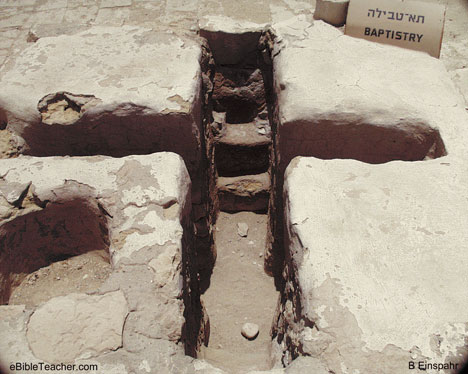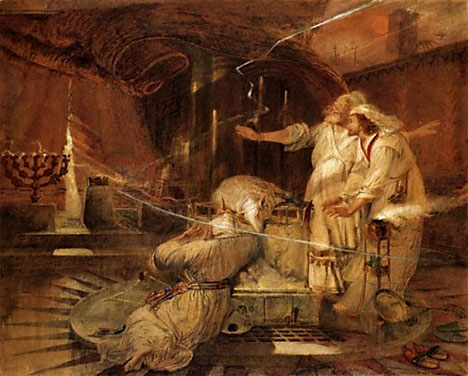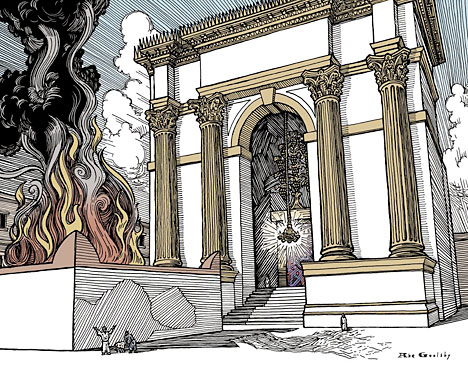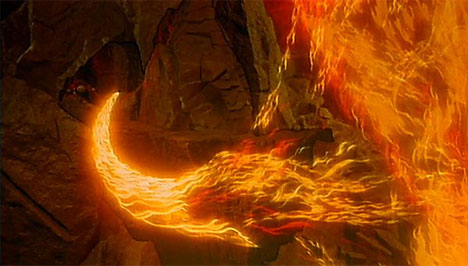Jun
21
2012
or Blood versus Water

They answered and said to Him, “Abraham is our father.” Jesus said to them, “If you were Abraham’s children, you would do the works of Abraham… You are of your father the devil, and the desires of your father you want to do.” (John 8:39, 44)
The theme of seed and fruit, or genealogy and mission, runs throughout the Bible. Genealogy is entirely objective. Our heredity is a factor in which we have no choice. It is the tree of life. But the fruit of our lives, what we choose to do with that life, involves our volition. Volition is mission. “It’s not about the hand you are dealt; it’s about how you play it.”
Continue reading
9 comments | tags: Baptism, Circumcision, Covenant Theology, Federal Vision, Film, John, Leviticus | posted in Bible Matrix, Biblical Theology, The Last Days
Jun
19
2012
or The New Commandment
1 John 5: 1-12 | Sermon Notes | 17 June 2012

Introduction
Jewish Christians were first opposed by unbelieving Jews, then by Jews who said they believed. Members of this latter group are called “Judaizers,” and they were the false teachers whom the apostles condemn in their letters.
Not only did these men pervert the gospel by including adherence to the Law of Moses, they also failed to keep the commandments of Jesus. This was Pharisaism dressed up in Christianity, the old leaven carried into the new age. The Pharisees loved to control people, while they failed to control themselves. This is the context of John’s letters to Jewish Christians: despite their profession, these men would be exposed by their lack of of certain things in their character.
Continue reading
Comments Off | tags: Baptism, Circumcision, Covenant curse, Covenant Theology, John, Literary Structure, Mission, Pharisees, Sermons, Ten Commandments | posted in Bible Matrix, Biblical Theology, The Last Days
Jun
15
2012

“In circumcision, Adam was Divided.
In baptism, Adam is Conquered.”
It seems to me the assumption that the New Covenant “people” includes infants because the Old Covenant people did has to overlook Pentecost. Are we to believe that once the Gentiles were included things went back to business as usual, with churches simply serving as Jew-Gentile hybrid synagogues, another “genealogical” people of God?
Continue reading
Comments Off | tags: Baptism, Circumcision, Pentecost | posted in Biblical Theology
Feb
14
2012

“Let this mind be in you which was also in Christ Jesus, who, being in the form of God, did not consider it robbery to be equal with God, but made Himself of no reputation, taking the form of a bondservant, and coming in the likeness of men. And being found in appearance as a man, He humbled Himself and became obedient to the point of death, even the death of the cross. Therefore God also has highly exalted Him and given Him the name which is above every name, that at the name of Jesus every knee should bow, of those in heaven, and of those on earth, and of those under the earth, and that every tongue should confess that Jesus Christ is Lord, to the glory of God the Father.” (Philippians 2:5-11)
This passage (or pericope?) retraces the Covenant pattern, which is also played out in the flow of the history of Israel. We’ll have a look at the structure of the passage and then I want to discuss the significance of the literary placement of “every tongue.”
WARNING: Weird ahead.
[This post has been refined and included in Sweet Counsel: Essays to Brighten the Eyes.]
Continue reading
2 comments | tags: Achan, AD70, Babel, Babylon, Circumcision, Covenant Theology, Evangelism, Genesis, Herod, Joshua, Moses, Pentecost, Philippians, Postmillennialism, Systematic typology, Tabernacle, Tongues | posted in Bible Matrix, Biblical Theology, The Last Days
Feb
8
2012
Atonement and Enthronement

“Jesus does what no medicine man
or witch doctor is able to do.”
And they came to Jesus and saw the demon-possessed man,
the one who had had the legion, sitting there,
clothed and in his right mind, and they were afraid. – Mark 5:15
Rich Bledsoe’s old blog is a goldmine. Here’s an excerpt from The Dysfunctional Family of the Gadarene Madman.
Continue reading
Comments Off | tags: Abel, AD70, Atonement, Cain, Circumcision, Edwin Friedman, Feasts, Genesis, James Jordan, Job, Matthew, Rene Girard, Revelation, Rich Bledsoe | posted in Biblical Theology, Quotes, The Last Days
Feb
6
2012
or Ethnic Cleansing as Mercy

“In representative terms, the people of God are no longer the Land but the heavenly Sea. The Church herself is the oncoming storm.”
In The Days of Vengeance [PDF], David Chilton did a great job of introducing many of us to the fact of Jesus’ use of “cosmic language” in Matthew 24 to describe the end of the Old Covenant. Not only is the idea of an actual, physical star falling to earth impossible (can you imagine the sun “falling to earth”?) but Jesus is quoting from a prophecy against Babylon. His audience would have realized this as a scathing attack against the Herods and their “government controlled” Temple worship. So, the language is clearly poetic, but why would the prophets—and Jesus and His apostles—deliberately cause so much confusion by using cosmic language to describe non-cosmic events? The answer is found in the mercy of God.
Continue reading
3 comments | tags: AD70, Baptism, Circumcision, Communion, Postmillennialism, Tabernacle, Temple | posted in Against Hyperpreterism, Bible Matrix, Biblical Theology, The Last Days
Jan
16
2012

The word apocalypse does not denote the end of the world. It is literally a revelation, a revealing.
In his Pauline Theology paper, It’s the end of the flesh as we know it! A comparison of circumcision & apocalypse (2010), Steven Opp provides support for the identification of the book of Revelation as a Covenant lawsuit. Christ was circumcised, then Christ Himself was cut off. Israel was circumcised in Christ, then, in AD70, after decades of apostolic gospel witness, unbelieving Old Covenant Israel and its Temple worship, overseen by “the mutilation,” were cut off. On the final Day of Coverings, the flesh was exposed.
Continue reading
Comments Off | tags: Circumcision, Covenant Theology, Galatians, James Jordan, Paul, Peter Leithart, Power of the Gospel, Revelation, Steven Opp | posted in Biblical Theology, Quotes, The Last Days
Dec
7
2011

This post concerns the Covenant-literary structure of 2 Thessalonians 2. The context and audience are first century, but it amazes me how willing we modern Christians are to do intricate hermeneutical acrobatics to avoid the obvious conclusion that the particular “coming” of Christ referred to here was also a first century event – the end of the Old Covenant in AD70.
A reasonably close look at the text makes it inescapable. A very close analysis makes it inexcusable, especially once we are versed in the literary mechanics of the Bible Matrix. Continue reading
1 comment | tags: AD70, Atonement, Circumcision, Covenant curse, Covenant Theology, Hermeneutics, Herod, High Priest, Jericho, Paul, Thessalonians, Urim and Thummim | posted in Bible Matrix, Biblical Theology, Ethics, The Last Days
Nov
28
2011
1 Peter 2:4-10 | Sermon Notes

Cut and Uncut Stones
4 As you come to him, the living Stone—rejected by humans but chosen by God and precious to him—
Peter’s use of the stone image should bring many Old Testament images to mind:
- the precious stones of Havilah, intended to be mined from the Land to glorify the sanctuary [1]
- the false stones of Babel (they had brick for stone)
- Jacob’s head on the altar stone, in a deep sleep
- Jacob’s raising of an altar stone in Bethel: “And this stone which I have set as a pillar shall be God’s house, and of all that You give me I will surely give a tenth to You.”
- Zipporah’s sharp stone of circumcision
- Moses enthroned on a stone at the defeat of Amalek
- Israel’s altars of stone (one stone for each tribe) at Sinai and Carmel
- The precious stones on the breastplate of the High Priest
- The tablets of stone carrying the ten words
- The stones of the “Levitical” house in the city filled with plague
- The stones of judgment, the ground itself as a witness executing transgressors outside the camp
- The black and white stones in the ephod
We have two types of stones: uncut stones (altar, judgment – the Law) and cut, or precious, stones (glory and riches – Grace).
Continue reading
1 comment | tags: Circumcision, Exodus, Ezekiel, Genesis, Havilah, Hebrews, High Priest, Peter, Satan, Sinai, Solomon, Tabernacle, Temple | posted in Bible Matrix, Biblical Theology
Jul
25
2011

Doug Wilson writes:
“As far as the Jews were concerned, the Bible teaches that because they were born into an Israelite family, circumcised in the covenant on the eighth day, they were attached to the tree. This attachment was an objective historical fact. But the sin and hypocrisy of many of them was also an objective fact, and the Lord of the Orchard consequently removed their branches, and grafted in other branches. Now the interesting thing here is that Paul turns and warns the Gentiles who had been grafted in against the very same sin committed by their fruitful predecessors” (To a Thousand Generations, p. 89).
Pastor Wilson writes that Israel is still the tree, but that the ascended Christ is Israel. I dispute the assumption that “natural branches” are still possible. The tree is now supernatural.
Continue reading
2 comments | tags: Baptism, Circumcision, Doug Wilson, High Priest, Peter Leithart | posted in Biblical Theology



































